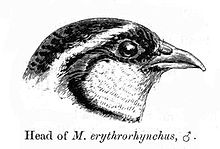Painted bush quail
| Painted bush quail | |
|---|---|

| |
| A male P. e. erythrorhyncha with chick. | |
| Scientific classification | |
| Domain: | Eukaryota |
| Kingdom: | Animalia |
| Phylum: | Chordata |
| Class: | Aves |
| Order: | Galliformes |
| Family: | Phasianidae |
| Genus: | Perdicula |
| Species: | P. erythrorhyncha
|
| Binomial name | |
| Perdicula erythrorhyncha | |
| Synonyms | |
|
Microperdix erythrorhynchus | |
The painted bush quail (Perdicula erythrorhyncha) is a species of quail found in the hill forests of India. They move in small coveys on hillsides and are distinguished by their red bills and legs. They have a liquid alarm call and small groups will run in single file along paths before taking flight when flushed.
Description

This quail is darkish brightly colored with a deep red bill and legs, eye-catching even in flight. The female has brick-red underpart and lacks the white throat and head stripe of the male. The male has a black face with a white supercilium and throat. These quail are typically found in a covey of 6 to 10 birds. They come out in open grassy patches or on forest roads and cart tracks to feed on seeds or grain (and small insects[3]) and dust-bathe in the morning and evening. The covey quickly reunites by the constant call of the members to one another. A series of soft whistles are heard when members of a scattered covey regroup. The territorial call of male is a pleasant, oft-repeated triple note kirikee-kirikee-kirikee.[4][5][6]
It is 6.6–7.5 in (17–19 cm) long and weighs roughly 2.4–3.1 oz (68–88 g).[7]
Distribution and habitat
This species is mainly found in the hill forests of peninsular India. There are two apparently disjunct populations. Subspecies blewitti is found in the
Behaviour and ecology

These quails are usually seen in small groups of 8 to 10. When flushed they scatter in different directions and then begin rally calling to reunite. Males are believed to be monogynous.[11] They are pugnacious and trappers are known to use decoy males to capture others.[12] The call of the breeding male is a kirkee..kirkee and other calls include soft whistles which rises and falls in pitch.[11] The
A flagellate parasite Hypotrichomonas avium (
References
- . Retrieved 12 November 2021.
- ^ a b Sykes, W.H. (1832). "Catalogue of Birds (systematically arranged) of the Rasorial, Grallatorial, and Natatorial Orders, observed in the Dukhun". Proceedings of the Zoological Society of London. Part 2: 149–172.
- ^ Mason, C.W. (1912). "The food of birds in India". Memoirs of the Department of Agriculture in India. Entomological Series. 3: 234.
- ^ Primrose, AP (1916). "Notes on the Painted Bush Quail Microperdix erythrorhynchus F.B.I. 1359". J. Bombay Nat. Hist. Soc. 24 (3): 597.
- ^ a b Jerdon, TC (1864). The Birds of India. Volume 3. George Wyman & Co. pp. 584–585.
- ^ Rasmussen PC & JC Anderton (2005). Birds of South Asia: The Ripley Guide. Volume 2. Smithsonian Institution & Lynx Edicions. pp. 125–126.
- ^ Hume, A.O.; Marshall, C.H.T. (1880). Game Birds of India, Burmah and Ceylon. Vol. II. Calcutta: A.O. Hume and C.H.T. Marshall. p. 127.
- ^ Price, Trevor D. (1980). "The seasonality and occurrence of birds in the Eastern Ghats of Andhra Pradesh". Journal of the Bombay Natural History Society. 76 (3): 379–422.
- ^ Hume, A.O. (1874). "Novelties. Microperdix blewitti, Sp. Nov". Stray Feathers. 2 (6): 512–513.
- ^ Sykes, W.H. (1857). "On the Geology of a portion of Dukhun, East Indies". In Carter, Henry J. (ed.). Geological papers on Western India, including Cutch, Sinde, and the South-East coast of Arabia. Bombay: Government of India. pp. 89–115.
- ^ a b c Ali, S & SD Ripley (1980). Handbook of the Birds of India and Pakistan. Volume 2 (2nd ed.). Oxford University Press. pp. 51–53.
- ^ Baker, EC Stuart (1924). "The game birds of India, Burma and Ceylon. Part 37". J. Bombay Nat. Hist. Soc. 29 (4): 850–863.
- ^ Daly, WM (1887). "The Bush Quail Perdicula erythroryncha". J. Bombay Nat. Hist. Soc. 2 (2): 149.
- PMID 5535603.

